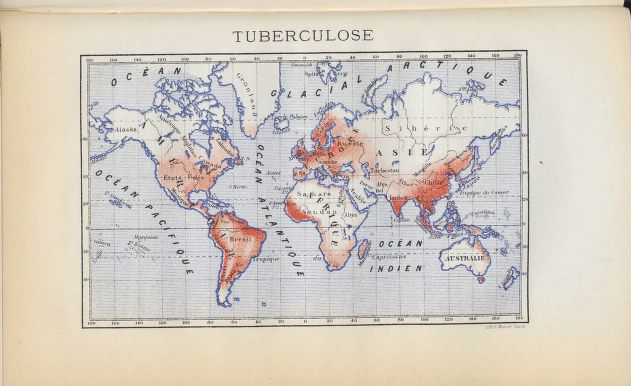Tuberculosis in Europe and North America, 1800–1922
 Poincaré, Émile Léon. Prophylaxie et géographie médicale :des principales maladies tributaires de l’hygiène. From the holdings of Center for the History of Medicine/Francis A. Countway Library of Medicine—Harvard Medical School.
Poincaré, Émile Léon. Prophylaxie et géographie médicale :des principales maladies tributaires de l’hygiène. From the holdings of Center for the History of Medicine/Francis A. Countway Library of Medicine—Harvard Medical School.
Tuberculosis, also known as “consumption,” “phthisis,” or the “white plague,” was the cause of more deaths in industrialized countries than any other disease during the 19th and early 20th centuries. By the late 19th century, 70 to 90% of the urban populations of Europe and North America were infected with the TB bacillus, and about 80% of those individuals who developed active tuberculosis died of it.
Causes of Tuberculosis
For most of the 19th century, tuberculosis was thought to be a hereditary, constitutional disease rather than a contagious one. By the end of the 19th century, when infection rates in some cities were thought by public health officials to be nearly 100%, tuberculosis was also considered to be a sign of poverty or an inevitable outcome of the process of industrial civilization. About 40% of working-class deaths in cities were from tuberculosis.
Robert Koch’s identification of the tuberculosis bacillus in 1882 helped to convince members of the medical and public–health communities that the disease was contagious. Preventing the spread of tuberculosis became the motivation for some of the first large-scale public health campaigns.
The sanatoria movement, which began around 1880, was an attempt to cure tuberculosis naturally and to prevent its spread by moving patients into quiet environments, isolated from normal life, where the air was pure and freely circulating. Major sanatoria included those in Davos, Switzerland, and Saranac Lake, New York.
At a sanatorium, rest in the open air was of paramount importance, and special houses, porches, and cabins were built to allow easy access to the outdoors. Because the sanatorium cure involved long periods of separation from home, work, and family, it was sometimes avoided until the disease was well advanced. Cost also was a deterrent.
The sanatorium model was adapted for use in urban environments, and dispensaries, free public clinics for the poor, also advised patients using the sanatorium model. However, following the dispensary’s advice was often difficult because of urban living conditions. If a patient had the means and the opportunity, moving to a different, more beneficial climate was another way to attempt a cure.
Tuberculin
After Koch’s identification of the bacillus, hopes for a cure ran high. Despite enthusiastic publicity Koch’s tuberculin treatment, announced in 1890, proved mostly useless—and sometimes harmful—though it did turn out to be helpful in diagnosing the diasease.
Diagnosis: Percussion, the Stethoscope, and the X-ray
Until the development of antibiotics in the 1940s, major clinical developments surrounding tuberculosis involved diagnosis rather than cure.
Leopold Auenbrugger published Inventum novum ex percussione thoracis humani ut signo abstrusos interni pectoris morbos detegendi (“On percussion of the chest”) in 1761.
R. T. H. Laennec, associated with the French Clinical School, published Del’ascultation mediate (On Mediate Auscultation, or, Treatise on the Diagnosis of the Diseases of the Lungs and Heart) in 1819, describing his invention and use of the stethoscope.
In the early 1900s, the x-ray, discovered by Wilhelm Conrad Röntgen in 1895, became a widely used diagnostic tool.
Decline in Mortality
Mortality rates began declining in the late 19th century throughout Europe and the United States. Whether sanitary measures, sanatoria, improved nutrition, or larger epidemiological factors unrelated to human intervention were the cause of this decline remains undecided.
Selected Contagion Resources
This is a partial list of digitized materials available in Contagion: Historical Views of Diseases and Epidemics. For additional materials on the topic “Tuberculosis in Europe and North America, 1800–1922,” click here or search the collection’s Catalog and Full Text databases.